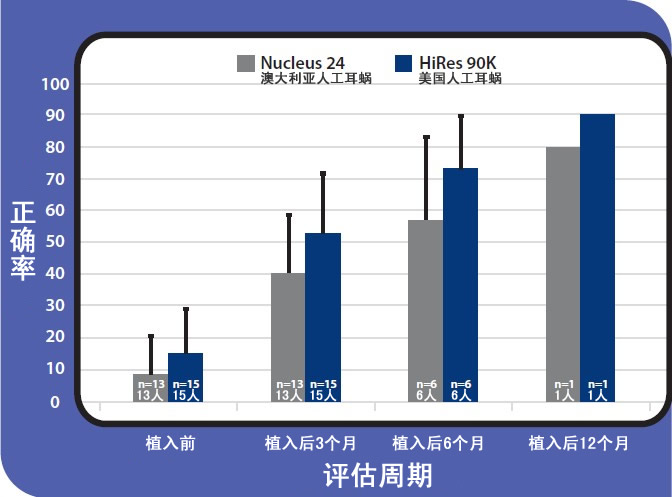|
|
Auditory and Language Abilities in Children: Comparison of Two Different Cochlear Implant Systems
Maria Cecilia Bevilacqua, Ph.D.
Natália Barreto Frederigue, Ph.D.
Leandra Tabanez Nascimento, Ph.D.
Márcia Yuri Tsmura Kimura
Adriane Lima Mortari Moret, Ph.D.
Orozimbo Costa, M.D.
University of Sao Paulo, Bauru, Brazil
“The results of this study suggest
differences in acquisition of
auditory and oral language skills for
children implanted with either
HiRes 90K or Nucleus 24 devices,
at least in those skill areas assessed. . .”
Children receive cochlear implants at increasingly younger ages because of technological advances that have led to more reliable diagnosis of hearing loss (Kirk, 2000; Kishon-Rabin et al, 2005). However,the evaluation of auditory and oral language abilities remains a challenge because traditional tests of speech understanding are not appropriate for these young children. Alternatively, measures that use parental report or other types of questionnaires and classification scales designed to capture behavior in everyday situations are useful tools with these young children. In this study, auditory and oral language abilities were tracked with two tools that use a parent-interview technique to assess the development of auditory skills (Infant-Toddler Meaningful Auditory Integration Scale or IT-MAIS) and oral language (Meaningful Use of Speech Scale or MUSS). Both tools were translated and adapted to Portuguese for this study.
Thirty-four children participated in the study. Eighteen used the HiRes 90K implant (Group 1) and 16 children used the Nucleus 24 device (Group 2). Children in each group were matched based on age at implantation (range = 1 year, 2 months to 3 years, 5 months). Mean age at implant was 2 years, 2 months for Group 1 and 2 years for Group 2. Children in both groups had similar socioeconomic status and were followed by the same team of professionals. The IT-MAIS and MUSS were administered prior to implantation, and after 3, 6, and 12 months of device use.
There was significant improvement between the preimplant and three-month scores on the IT-MAIS (Figure 1) and MUSS (Figure 2) for both groups of children. Notably, there was a trend for better performance by the children in Group 1 (HiRes 90K users) than Group 2 (Nucleus 24 users) on both measures, with significant differences between groups on the MUSS at three months (p = 0.029).
The results of this study suggest differences in acquisition of auditory and oral language skills for children implanted with either HiRes 90K or Nucleus 24 devices, at least in those skill areas assessed by the IT-MAIS and MUSS. These differences are likely related to the sound processing implemented with each device. Further investigation is needed to validate these results.
References
Kirk KI. (2000) Challenges in cochlear implant outcomes. In: Niparko J, ed.
Cochlear Implants: Principles and Practices. New York: Lippincott Williams &
Wilkins, 225-259.
Kishon-Rabin L, Taitelbaum-Swead R, Ezrati-Vinacour R, Hildesheimer H. (2005)
Prelexical vocalization in normal hearing and hearing-impaired infants before and
after cochlear implantation and its relation to early auditory skills. Ear Hear
26(Suppl 4):17S-39S.
==============================中文==============================
儿童听觉和语言能力方面,两种不同人工耳蜗植入系统的比较
aria Cecilia Bevilacqua,博士
Natália Barreto Frederigue,博士
Leandra Tabanez Nascimento,博士
Márcia Yuri Tsmura Kimura
Adriane Lima Mortari Moret,博士
Orozimbo Costa,医学博士
巴西,包鲁,圣保罗大学
“此项研究间接表明,至少在上述技能方面,用...评估,使用HiRes 90K和Nucleus 24的儿童植入者在获得听觉和口语技能方面是有差别的。”
由于技术的发展已经导致更可靠的听力损失诊断方法成为现实,儿童接受人工耳蜗植入的年龄越来越小。然而,听觉和口语技能评估手段依然面临挑战,因为传统的言语理解测试手段不适用于这些小年龄的孩子。我们只能依靠父母的报告或是其他类型的设计用来记录日常行为的问卷调查和分级标准等有用的办法来衡量这些小年龄孩子的听觉和语言技能。
此项研究中,我们采用父母问卷的方式,用两种量表——“婴幼儿有意义听觉整合量表(IT-MAIS)”和“有意义言语使用量表(MUSS)”——记录听觉和口语能力。两种量表都被翻译成葡萄牙语言(巴西官方语言),以适用于此项研究。
34名孩子参与了此项研究。18名孩子使用的是HiRes 90K植入体(第1组),16名孩子使用的是Nucleus 24设备(第2组)。每一组的孩子按照植入年龄进行匹配(范围:1年、2个月到3年、5个月)。“表1”的平均植入年龄为2年、2个月;“表1”的平均植入年龄为2年。每一组的孩子拥有相似的社会经济状况,接受相同专业人员的指导。两种量表执行时间:植入前、植入后的3、6、12个月。
每组孩子植入前和植入三个月IT-MAIS(表1)和MUSS(表2)的分数有重大的提升。特别要提到的是,研究结果表明一个趋势:在两种量表的测试中,与第2组孩子(Nucleus 24使用者)相比较,第1组孩子(HiRes 90K使用者)的表现要更好一些。
此项研究间接表明,至少在上述技能方面,用IT-MAIS和MUSS两种量表做评估,使用HiRes 90K和Nucleus 24的儿童植入者在获得听觉和口语技能方面是有差别的。这种差别很可能跟每个设备的声音处理工具有关。结论仍需进一步的研究。
参考书目:
Kirk KI. (2000) Challenges in cochlear implant outcomes. In: Niparko J, ed.
Cochlear Implants: Principles and Practices. New York: Lippincott Williams &
Wilkins, 225-259.
Kishon-Rabin L, Taitelbaum-Swead R, Ezrati-Vinacour R, Hildesheimer H. (2005)
Prelexical vocalization in normal hearing and hearing-impaired infants before and
after cochlear implantation and its relation to early auditory skills. Ear Hear
26(Suppl 4):17S-39S.
附表:

Figure 1. Mean scores and standard deviations for the IT-MAIS
over time for children implanted with HiRes 90K or Nucleus 24
devices.
表1:随着时间的推移,植入HiRes 90K或Nucleus 24的孩子们IT-MAIS评估得出的平均分数和标准偏差

Figure 2. Mean scores and standard deviations for the MUSS
over time for children implanted with HiRes 90K or Nucleus 24
devices.
表2:随着时间的推移,植入HiRes 90K或Nucleus 24的孩子们MUSS评估得出的平均分数和标准偏差
|
|
 /1
/1 